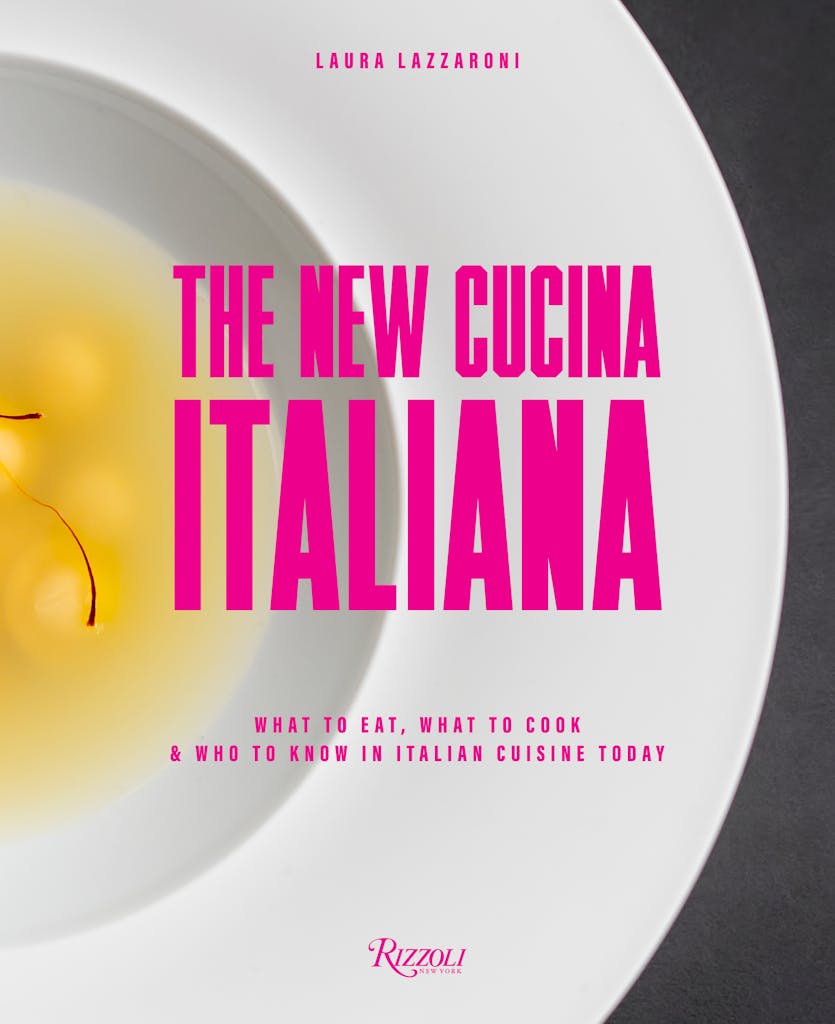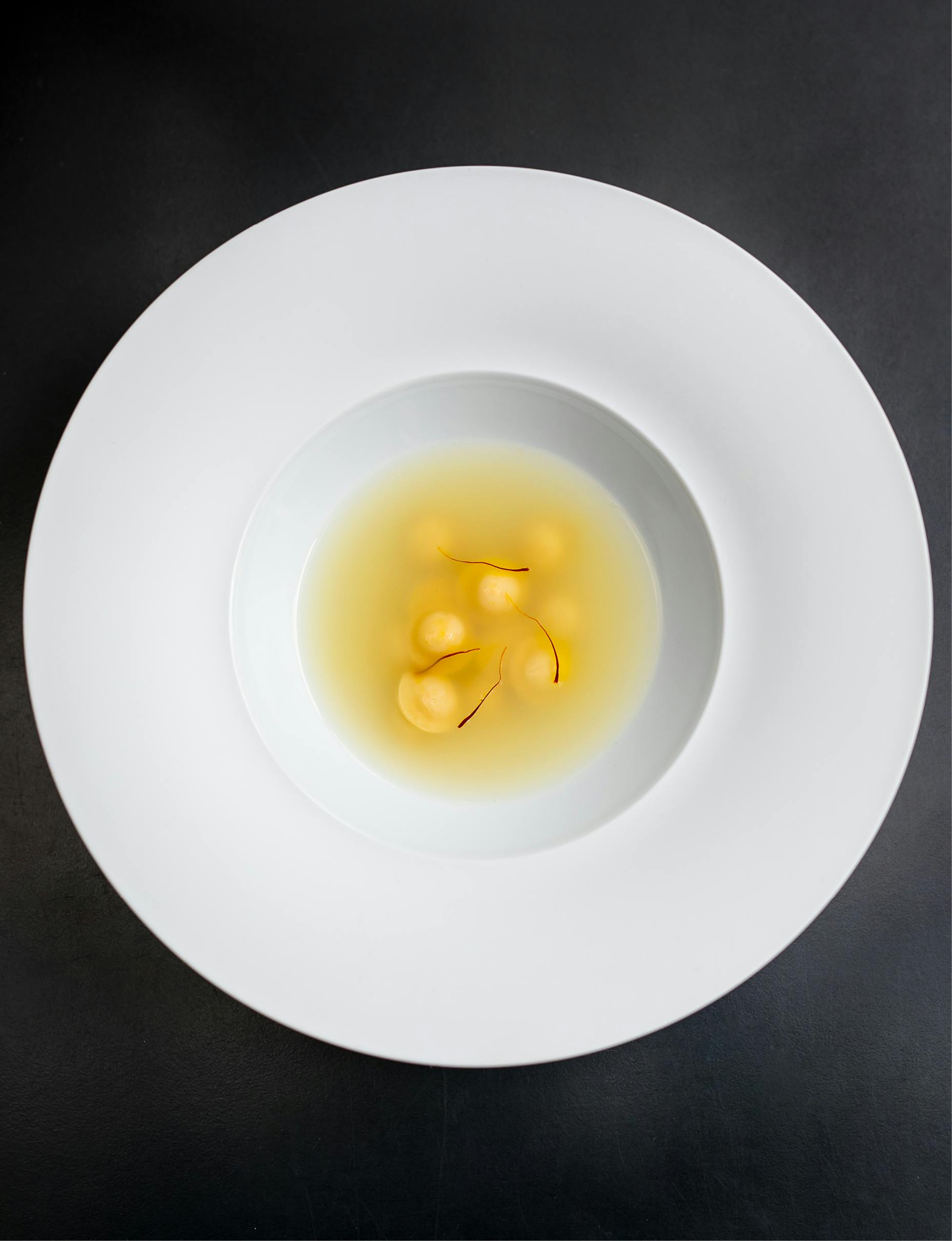S.A.L.T. Lab Radio: Following the New Cucina Italiana with Revolutionary Chef Niko Romito
S.A.L.T. Lab Radio’s latest episode, The Geography of Pasta, introduces us to the world of artisanal pasta. Laura Lazzaroni, author of the soon-to-be-released The New Cucina Italiana, to be published in March 2021 by Rizzoli, shares how chefs are discovering that pasta can act as a canvas for fresh ideas.
Barely glance at it, and you just might mistake it for a plate of tortellini in brodo. Now, look again. See how the fresh pasta domes – definitely not tortellini – float in a golden, slightly opaque broth? You can tell that broth has substance and elegance, but most importantly that it packs flavor. And then there’s those rust-colored threads: what are they?
When Niko Romito, a 3-star Michelin chef, first introduced Assoluto di Cipolle, Parmigiano e Zafferano Tostato (“Absolute” Onion with Parmesan-filled Pasta Buttons and Toasted Saffron) ten years ago, it was quite the sensation. He had dared to revisit the quintessentially Italian pasta fresca ripiena in brodo (fresh filled pasta in a broth), in a way that was as sublime as it was groundbreaking. To begin with, the broth is not broth: it’s 100% onion extraction, with no added water. He obtains it with a professional extractor (at home you can use a food processor and a fine mesh sieve), sweet and slightly tangy. Then there’s the fresh pasta “buttons”, with a pasta-to-filling ratio perfectly calibrated to support the savory Parmesan cream.
The 46-year-old chef tops it off with saffron pistils: one of the most prized products of his native Abruzzo. It’s painstakingly harvested by hand near the small town of Navelli, by the Gran Sasso massif (wedged between the Apennines and the Adriatic Sea, in central Italy, the region is as breathtaking as it is uncharted). They are quickly toasted and release a balsamic zap when they hit the onion juice.
As you load your spoon with just onion, onion and saffron, onion and pasta, you’ll get a syncopated beat of flavor bombs.
It’s shockingly comforting for something that is also this elegant. It also feels somewhat familiar. And this is Romito’s cooking philosophy. He applies an almost obsessive knowledge of food science to the best ingredients, mostly drawn from the rural and pastoral traditions of his territory, with a particular penchant for vegetables. The result is a new culinary canon, built on the interplay of the purest flavors and textures, dishes that are complex but somehow feel simple, and almost archetypical. Tasty as hell.
As with all things Romito, other chefs have taken note. Today the word “assoluto” – meaning the extreme distillation of a certain ingredient – has become culinary vernacular, and this dish has spurred many an homage. A bold entrepreneur, Niko has infused the same philosophy in all his projects: from Reale (his idea of fine dining, housed in a stunning 16th century former Abruzzese monastery) to the restaurants he has opened abroad for Bulgari Hotels; from Spazio (his “smart casual” concept, in Milan and Rome) and Alt (his “Italian diner”, where he also maintains a cutting-edge bread and pastry production). There’s also Intelligenza Nutrizionale, the healthy canteen concept he designed for hospitals. Romito is also a true mentor, operating a campus (Accademia Niko Romito) near Reale.

No wonder I devoted to Romito the opening chapter of The New Cucina Italiana, my new book (with Assoluto as the cover image). It examines the “movement” that is reshaping Italian cuisine. When I tell people I wrote a book about the “new cucina Italiana,” I can see a mild panic spread over their face. I know in their mind they’re forming images of deconstructed Milanese veal cutlets and molecular lasagna. I can’t blame them. Particularly at times like these, a canon of comfort is something to find solace in and protect, not something to mess with.
But the new cucina italiana is far from scary.
For the longest time, the idea of gastronomy we have exported has relied on super traditional fare like cacio e pepe and amatriciana, or the fireworks of star chef Massimo Bottura. While there’s nothing wrong with either (Bottura is a genius, and God bless amatriciana), our contemporary cuisine is much more. Young women and men, from North to South, are rethinking the formats of the Italian restaurant, from fine dining to neo-trattoria. They’re rediscovering foraging and farming, introducing cocktail programs, expanding their worldly influences, honing their techniques and coming together as a fun-loving collective.
They approach tradition with a respectful perspective, but they have finally emancipated from the nonna narrative, taking the good (i.e. a shared vocabulary of Italianissimi flavors) and leaving the bad (not all that nonna did in the kitchen was right – and many of these young guns’ grandmothers never even turned on the stove).
For many months I have traveled the country to collect their stories and recipes. The result is nothing short of a labor of love and couldn’t come out at a better time: restaurants in Italy as all over the world are facing extreme hardship. But I am optimistic. I hope you will soon be able to travel again and come taste the new cucina italiana. Until then, I hope you’ll enjoy the book.
Assoluto di Cipolle, Parmigiano e Zafferano Tostato

Ingredients:
- 1 cup (3.5 oz.) freshly grated Parmigiano Reggiano
- 3 tablespoons heavy cream
- Fresh egg pasta sheets (recipe follows)
- 2 cups rock salt or coarse kosher salt
- 4.5 lbs. medium yellow onions
- ¼ teaspoon pure vitamin C powder (ascorbic acid)
- Salt
- ½ teaspoon white wine vinegar, or to taste
- 12 saffron pistils
For the fresh egg pasta (Makes 4 pasta sheets):
- 3 ½ cups (17 oz.) 00 flour
- 4 large eggs
- 5 large egg yolks
- ½ teaspoon white wine vinegar
Special equipment:
- ¾ inch ring mold or round cookie cutter
- Cheesecloth
- Pasta machine
To make the fresh egg pasta:
- Pour the flour into a large bowl, create a mound with a crater in the center. Add the eggs, egg yolks, and vinegar to the crater; use your fingers or a fork to gradually mix the eggs into the flour until it comes together in a crumbly mass.
- Pour onto a lightly floured work surface and knead for 5 to 7 minutes until the dough is very smooth and elastic. If it is sticky, knead in a teaspoon of flour at a time until it doesn’t stick to your hands when touched.
- Wrap tightly in plastic wrap and allow it to sit in the refrigerator for 30 minutes to 1 hour.
- Remove dough from refrigerator and discard plastic wrap. Cut the dough into 4 pieces and flatten each piece into a rough rectangle. Lightly dust the rollers of a pasta machine with flour and pass one piece of dough through the machine on the largest setting (keep other pieces of dough covered with plastic wrap in the meantime, to avoid drying them out). Fold the dough in thirds and pass through the rollers again. Continue rolling the dough through the machine, dusting with flour as necessary and adjusting to a smaller setting each time, until the sheet is very thin, about 1 mm. Transfer pasta sheet to a flour-dusted work surface and cover with a clean kitchen towel.
- Repeat with remaining dough.
Method:
- Stir together the Parmigiano Reggiano and heavy cream until a smooth, dense paste forms. With your hands, form tiny balls from the cheese mixture, about the size of a small chickpea. Lay a sheet of fresh pasta dough on a clean work surface and cut in half lengthwise. Starting from the short edge, place balls of the Parmigiano mixture down the length, spacing them an inch apart. Brush dough around the filling lightly with water and gently press down on the filling with your thumb to flatten the Parmigiano balls into button shapes.
- Top with second half of dough, pressing around each mound with your fingertips to seal and push out any air pockets. Using a ¾ inch ring mold or round cookie cutter, cut around the buttons, only slightly wider than the filling. Press around the edges with fingertips to seal again if necessary. Repeat with remaining dough and filling. Gently transfer finished buttons to a tray lightly dusted with semolina and refrigerate, uncovered, overnight.
- Preheat oven to 325°F. Line an 11×13 inch baking dish with parchment paper and cover the bottom with an even layer of rock salt or coarse kosher salt. Arrange the unpeeled onions on top of the salt; cover the dish tightly with aluminum foil and place in preheated oven. Cook without disturbing for 1 hour and 30 minutes. Remove from oven, discard aluminum foil and let cool at room temperature. When the onions are cool enough to handle, peel then place them in a food processor and blend until smooth. Pour the blended onions into a fine mesh sieve set over a wide bowl and let drain for at least 1 hour, stirring occasionally. Transfer the strained pulp to a large piece of cheesecloth, gather up the corners to create a pouch, and squeeze forcefully over the bowl to release all the liquid from the pulp. Add salt and vinegar to the onion extraction, taste and adjust flavors accordingly.
- Preheat oven to 150°F, or lowest heat setting. Place the saffron on a parchment-lined baking tray and toast in dry in preheated oven for 2 to 5 minutes.
- Heat onion extraction in a small saucepan over medium heat until steaming, but do not boil. Bring a large part of water to boil over high heat; add 3 tablespoons salt. Cook ravioli for 1 to 2 minutes, or until they float to the surface. Drain in a colander. Divide ravioli between warm, shallow bowls and cover with a ladleful of onion extraction. Gently place 3 toasted saffron threads on the surface of the broth; serve immediately.
On S.A.L.T. Lab Radio’s podcast episode, “The Geography of Pasta,” Lazzaroni shares some great recommendations of restaurants, where chefs, from Abruzzo to Emilia Romagna, are creating innovative pasta dishes (and you can find more in The New Cucina Italiana, her upcoming book that will be published by Rizzoli in March 2021
).
